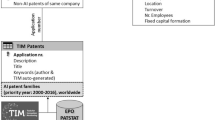Abstract
Nanotechnology is an emerging field of science with the potential to generate new and enhance existing products and transform the production process. US patent data is used to track the emergence of nanotechnologies since 1978. The nanotechnologies that have undergone the most development are identified using patent citation data and co-citation patterns of patents are examined to define clusters of related nanotechnologies. The potential for economic impact of the emerging nanotechnologies is assessed using a generality index.

Similar content being viewed by others
Notes
The number of citations data of each patent was collected in July 2009. Any citations after that date would not be in the dataset.
The sensitivity of the 50% threshold was analyzed by constructing clusters assuming thresholds of 40 and 60% of forward citations shared. When clusters were constructed with the stricter alternative threshold, 60%, the technology clusters identified did not change. Three of the clusters identified at the 50% level shrunk by one patent. When the looser threshold was used, two of the identified clusters expanded to include additional patents and one additional cluster was identified relating to creating structures with carbon nanotubes. We assumed the technology identified in this cluster was closely related to another cluster previously identified, Carbon nanotube production, and assumed inclusion of the additional cluster would be redundant.
To confirm the results of the co-citation cluster analysis, five faculty members at the University at Albany’s College of Nanoscale Science and Engineering were asked to review the results. They compared the 101 most cited patents and the seven nanotechnologies identified through cluster analysis. They concluded that the technologies identified captured significant developments in nanoscale technology development.
For example a patent that has 10 citations in 10 different patent classes will have a generality index of G = 1 − (0.102 + 0.102 + 0.102 + 0.102 + 0.102 + 0.102 + 0.102 + 0.102 + 0.102 + 0.102) = 0.9. A patent that has 10 citations evenly distributed across two patent classes will have a generality index of G = 1 − (0.502 + 0.502) = 0.5.
References
Basselcoulard, E., Lelu, A., & Zitt, M. (2007). Mapping nanoscience by citation flows: A preliminary analysis. Scientometrics, 70, 859–880.
Booker, R., & Boysen, E. (2005). Nanotechnology for dummies. New York: For Dummies.
Hall, B., & Trajtenberg, M. (2004). Uncovering GPTS with patent data. NBER Working Papers 10901, National Bureau of Economic Research.
Helpman, E., & Trajtenberg, M. (1998), Diffusion of general purpose technologies. In: E. Helpman (Ed.), General purpose technologies and economic growth (pp. 85–119). MIT Press.
Huang, Z., Chen, H., Yip, A., Ng, G., Guo, F., Chen, Z., et al. (2003). Longitudinal patent analysis for nanoscale science and engineering: Country, institution and technology field. Journal of Nanoparticle Research, 5, 333–363.
Huang, C., Norton, A., & Rasters, N. (2010). Nanoscience and technology publications and patents: A review of social science studies and search strategies. Journal of Technology Transfer.
Hullman, A. (2007). Measuring and assessing the development of nanotechnology. Scientometrics, 70, 739–758.
Hullmann, A., & Meyer, M. (2003). Publications and patents in nanotechnology: An overview of previous studies and the state of the art. Scientometrics, 58, 507–527.
Leydesdorff, L., & Zhou, P. (2007). Nanotechnology as a field of science: Its delineation in terms of journals and patents. Scientometrics, 70, 693–713.
Lux Research. (2004). The nanotech report.
Meyer, M. (2007). What do we know about innovation in nanotechnology? Some propositions about an emerging field between hype and bath dependency. Scientometrics, 70, 779–810.
Meyer, M., & Persson, O. (1998). Nanotechnology-interdisciplinarity, patterns of collaboration and differences in application. Scientometrics, 42, 195–205.
Mogoutov, A., & Kahane, B. (2007), Data search strategy for science and technology emergence: A scalable and evolutionary query for nanotechnology tracking. Research Policy, 36, 893–903.
National Science Foundation. (2010). Science and engineering indicators 2010. Two volumes (Vol. 1, NSB 10-01, Vol. 2 NSB 10-01A). Arlington, VA: National Science Foundation.
Porter, A., Youtie, J., Shapira, P., & Schoeneck, D. (2008). Refining search terms for nanotechnology. Journal of Nanoparticle Research, 10, 715–728.
Roco, M., & Bainbridge, W. (Eds). (2001). Societal implication sof nanoscience and nanotechnology. NSET workshop report. Arlington: National Science Foundation. http://www.wtec.org/loyola/nano/NSET.Societal.Implications/.
Small, H. (1973). Co-citation in the scientific literature: A new measure of the relationship between two documents. Journal of the American Society for Information Sciences, 24, 265–269.
The National Nanotechnology Initiative: Leading to the Next Industrial Revolution. (2000). White house press release. 21 Jan 2000. http://clinton4.nara.gov/WH/New/html/20000121_4.html.
Trajtenberg, M., Jaffe, A., & Henderson, R. (1997). University versus corporate patents: A window on the basicness of invention. Economics of Innovation and New Technology, 5, 19–50.
Wong, P. K., Ho, Y. P., & Chan, C. K. (2007). Internationalization and evolution of application areas of an emerging technology: The case of nanotechnology. Scientometrics, 70, 715–737.
Youtie, J., Iacopetta, M., & Graham, S. (2008). Assessing the nature of nanotechnology: Can we uncover an emerging general purpose technology? Journal of Technology Transfer, 33, 315–329.
Author information
Authors and Affiliations
Corresponding author
Appendix
Rights and permissions
About this article
Cite this article
Schultz, L.I., Joutz, F.L. Methods for identifying emerging General Purpose Technologies: a case study of nanotechnologies. Scientometrics 85, 155–170 (2010). https://doi.org/10.1007/s11192-010-0244-2
Received:
Published:
Issue Date:
DOI: https://doi.org/10.1007/s11192-010-0244-2




